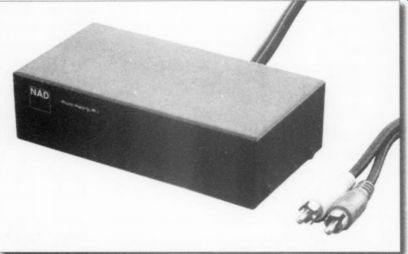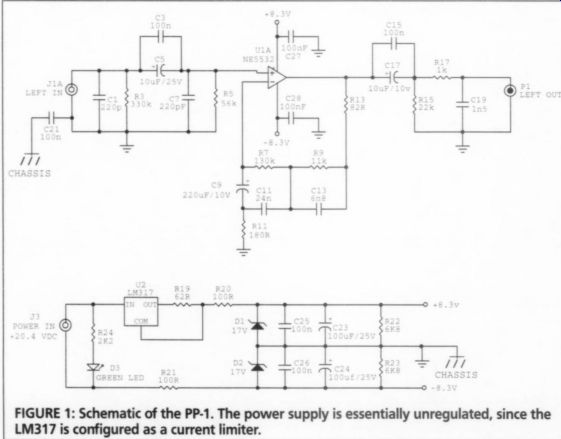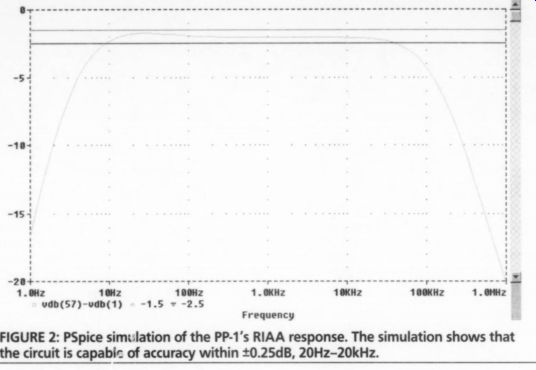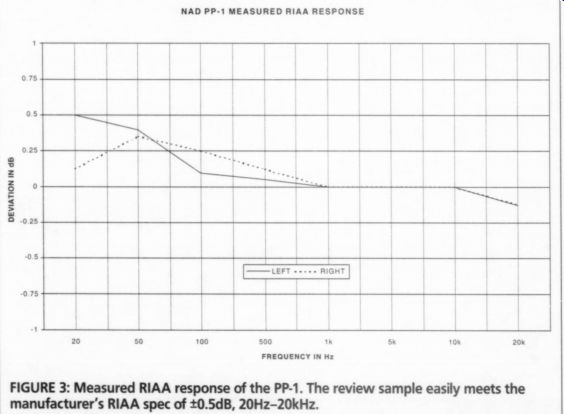NAD PP-1 Phono Preamplifier.
Phono preamplifiers are becoming less and less common in consumer audio equipment. Many preamps, integrated amps, and receivers are new made with out a phono section, since most buyers won't use them, and manufacturers wish to keep costs down. In home-theater equipment, phono preamps are practically nonexistent.
NAD has continued this trend in some of their recent audio products, including the excellent NAD 118 Digital Preamplifier, which I reviewed in AE 6/97. The NAD PP-1 Phono Preamplifier (Photo I) has been designed as a cost-effective add on for products without phono circuitry, such as the 118. I doubt that any audiophile who is heavily pro-LP would buy the 118 preamp, since all audio entering the 118 is converted to digital (heresy!).
All control functions are accomplished in the digital domain.
At $129 retail, the PP-1 makes no pre tense at being a world-beater high-end phono preamp. NAD has clearly tailored this preamp to digital-oriented audiophiles who still own a collection of LPs that they wish to be able to play, but who aren't too fussy about analog sound. The preamp gain is optimized for high-output magnetic cartridges-the PP-1 will not accommodate low-output moving coils. If you are still convinced that LPs are inherently better than CDs, the PP-1 won't be a good choice.
Like a lot of electronics these days, the PP-1 is "made in China." The PP-1 is utterly simple in function.

PHOTO 1: The NAD PP-1 phono preamp. The output interconnect cable is hard-wired to the unit.

FIGURE 1: Schematic of the PP-1. The power supply is essentially unregulated, since the LM317 is configured as a current limiter.
There are no controls-not even a power switch. The PP-1 is intended either to be left on all the time or plugged into a switched outlet on existing equipment.
An outboard "wall-wart" transformer with a built-in rectifier supplies raw DC to the PP-1 with a standard DC power connector. The chassis-mount input RCA connectors are what I call PT. Barnum type-the shield is gold-plated, but the center contact (invisible to the consumer) is tin-plated. The output connections consist of molded, gold-plated RCA plugs on a short, hard-wired cable.
Circuit Details
A schematic for the PP-1 is included with every unit (Fig. 1). I re-drew it using the Circuit Maker' Student Version, since the supplied copy was not clean enough for publication. The design is extremely simple.
---------- Some weg ay
Input overload (20Hz/1kHz/20kHz): 55/63/580mV
Rated distortion (THD, 20Hz-20kHz): 0.04% RIAA accuracy: +0.5dB
Dimensions: 135 x 35 x 70mm
---------------
An NE5532 dual op amp is the active device, half used for each channel (my sample was supplied with a KA5532, which is probably a Far-East equivalent).
R7, R9, C11, and C13 form the RIAA feedback network, with R17 and C19 taming the ultrasonic peak that would otherwise occur. C9/R11 set the low frequency -3dB point at 4Hz. The 1kHz gain is set at 38dB.
One percent metal-film resistors are used throughout, including the RIAA net work, but the capacitors are film types, with no tolerance indication. The electrolytic input and output coupling capacitors are bypassed with film types. The cartridge loading caps are ceramic disc (Photo 2).
The wall-wart power transformer is rated at 15V DC/300mV. Under the load provided by the PP-1, the unit outputs 21.5V DC. To keep the cost as low as possible, NAD has derived positive and negative supplies from a single LM317 (KA317 in my sample) three-terminal adjustable regulator. A phantom supply ground, connected to the chassis, is formed at the junction of R22 and R23, which is also the junction of the power-supply capacitors.
The input raw DC ground becomes the negative regulated supply rail.
Note that the output of the LM317 is taken from the adjust pin. In this configuration the LM317 really functions as a current limiter rather than a regulator (see the National Semiconductor LM117/317 data sheet for similar topologies). I checked the supply rails with a scope and found that both had 6 to 7 mV of peak-to-peak ripple.
I also plugged the wall-wart into my Variac and found that there is no supply regulation using this scheme--the DC rail voltages vary with line voltage. At a line voltage of 117V, the rails measure +9V DC. This is one of the sleaziest power supplies I've seen in a very long time. Even considering the cost of the PP-1, could not NAD have provided real supply regulation using a pair of fixed, three-terminal 7808 and 7908 regulators? If it raised the cost a couple of dollars, it would still have been well worth the expense.
I'm not sure why zener diodes D1 and D2 were included. Normally, these diodes would clamp the rails at +-17V, should the regulator fail. But, since the regulator isn't really a regulator, and each rail can't possibly go higher than half the raw DC voltage (or +-10.75V), the zeners are totally unnecessary (the 5532 op amp has an absolute maximum rating of +-22V). Eliminating them would have freed up a few cents, which NAD could have put toward real supply regulators.

FIGURE 2: PSpice simulation of the PP-1's RIAA response. The simulation
shows that the circuit is capable of accuracy within +0.25dB, 20Hz-20kHz.
Performance
I ran a PSpice simulation of the PP-1's RIAA circuit (Fig. 2).? The circuit is capable of RIAA accuracy of better than +0.25dB across the audible spectrum.
Figure 3 shows the measured response of the review sample. The right channel is quite close to the simulation, but the left shows an error of +0.5dB at 20Hz.
This is probably due to R7, the 130k resistor, being slightly out of tolerance.
My simulations show that an R7 value of 135k will produce this error. Nonetheless, the left channel is still well within the manufacturer's +0.5dB spec. This is quite respectable RIAA performance for such an inexpensive preamp.
Total harmonic distortion measurements were also well under the manufacturer's spec of 0.04%, 20Hz-20kHz. I measured 0.011% at 1kHz, 0.012% at 20Hz, and 0.012% at 20kHz in the left channel; the right channel was identical except at 20kHz, which measured 0.013%. Noise was -80dB relative to an output of 2V; NAD specifies the unweighted signal-to-noise ratio as 72dB, but they do not give the reference output for this measurement. In operation, the unit was subjectively silent.
I think it would be rather silly to give a detailed sonic description of the PP-1, relative to some absolute sonic bench mark. For $129 you can't expect high end performance, and you don't get it.
The PP-1 offers sound quality comparable to the phono sections of typical Far East receivers and integrated amps. The PP-1 doesn't do anything nasty to the music, and the casual LP collector will find it quite listenable.
Six years ago Victor Campos, then Director of Product Development and Engineering at NAD, lent me a prototype of a phono preamp NAD hoped to sell for between $200 and $250, but the product never materialized. This pre amp used a pair of Analog Devices AD743 op amps for the RIAA preamp and a power supply based on Linear Technology LT317 and LT337 three-terminal adjustable regulators. A moving coil input was also included, with the additional preamplification accomplished with a built-in head amp based on Analog Devices' AD797.
This preamp was several orders of magnitude better than the PP-1, and I firmly believe that most music lovers would have been willing to pay the extra price. NAD's decision not to manufacture this preamp was most unfortunate.

FIGURE 3: Measured RIAA response of the PP-1. The review sample easily meets the manufacturer's RIAA spec of +0.5dB, 20Hz-20kHz.
Summary
The NAD PP-1 is an unpretentious product that allows those firmly committed to digital audio to continue playing their LPs. As such, it is an ideal companion to the NAD 118 Digital Preamplifier, and will mate well with virtually any line stage preamp with a spare input. My main criticism of the PP-1, considering the price, is the poor power supply- even at this price NAD should have used an acceptable regulator.
Those who still own large collections of excellent-sounding LPs (myself included) will prefer something considerably better. But, if you are a casual LP listener, the PP-1 will fit the bill. For what it costs, and where it's likely to be used, the PP-1 is a safe recommendation.
Maufacturer’s response:
Thank you for the opportunity to comment on Gary Galo's review of the NAD PP-1. While Mr.
Galo's measurements confirm the excellent performance of this modestly priced device, I am puzzled by the negative tone of the review. Our concept for the PP-1 was to offer very good phono performance (low noise, low distortion, and accurate RIAA tracking) to partner with our own low-cost integrated amps and receivers that are no longer supplied with a phono input, or as an upgrade to the many "mass market" receivers, whose built-in phono stages cannot match the musical performance of the PP-1. When compared to other similar products, we believe the PP-1 more than holds its own, with typical NAD warmth and dimensionality to the sound and excellent rejection of induced noise and RF interference-a common problem with inexpensive add-on phono preamps.
There are several factual inaccuracies in Mr Galo's review. First of all, the schematic is n included with every PP-1, as this is NAD co right information that we consider confide intellectual property. Secondly, the OPA KA5532 and regulator KA317 are not "Far equivalents" of something better; rather, they are specifically chosen for their excellent performance. Both semiconductors are manufactured by Samsung.
As noted in the review, the resistors are a 1% metal film types, and the capacitors are 5% film types, again specifically chosen for sound quality and accurate RIAA performance.
It should also be noted that NAD uses the IHF specified cartridge load, not a 1k resistor, when designing and measuring phono circuits. This complex load gives results that are much closer to what listeners can expect in the real world outside the lab.
We take strong exception to what is refer to as "sleazy" design of the power supply. The design is entirely appropriate to the overall concept of the product, and gives very good results Mr. Galo has not analyzed the power sup schematic correctly. We are using current regulation for the power supply of the PP-1, n voltage regulation. We do not take the out from the adjust pin of the low-noise regulator rather, this is the feedback input that regulates the current output.
---------------
REFERENCES:
1. Circuit Maker is a superb schematic drawing program, with integrated SPICE, for the Windows 95/98 platform. A fully functional student version is available for free from the manufacturer's web site, microcode.com. The student version is limited to 50 parts per drawing, but is otherwise impressively loaded with features. A full-featured version and the companion PC board program cost $299 each ($549 if you buy them together). If you are looking for a Windows-based schematic pro gram, a visit to this web site is a must. I have ordered the full package.
2. For the PSpice simulations, I used a modified version of a program written by Walt Jung for Line Technology back in 1989. This program was sup plied by LT on a floppy disk to demonstrate the performance of a number of their opamps. Walt's RIAA program simulates the accuracy of a phono preamp he designed that is still featured on the front page of the LT1115 data sheet. | modified the code to operate under the text-based PSpice program supplied with MicroSym's DesignL ab V.8 Eval Release, and replaced the LT1028-based circuit with NAD's. Design Lab V. 8 is available for free from the OrCAD web site, orcad products/pspice/eval_f htm.
----------
This circuit was chosen to accommodate different types and voltages of outboard power supplies (wall warts?) required by the many different countries in which the PP-1 is sold. T circuit also has better ripple rejection and low noise than a voltage regulator would have this application. The zener diodes may seem redundant, but since many different outboard supplies are possible, they are a very important failsafe feature. By employing an outboard un regulated power supply and using internal cur rent regulation, we were able to keep the chassis size small and, yes, the cost low.
It is true that the PP-1 cannot be compared to the NAD prototype that Mr. Galo sampled several years ago. That phono section (in a much evolved form) is in production today as the S100/RIAA and retails for $299. It is avail able only as a plug-in module for the NAD S100 line stage preamp ($1,199), which supplies high regulated DC from its own rather complex power supply. The S100/RIAA accommodates both MC and MM cartridges and also includes provision for adjusting cartridge loading.
It is too bad that Mr. Galo did not actually compare the PP-1 with the built-in phono sections of today's typical Far East receivers. Far from being an afterthought or a bullet point on a spec sheet, the PP-1 is a very musically satisfying product that requires no apology for its technical specification. Greg Stidsen, Director of Sales and Marketing NAD Electronics of America.
Also see: